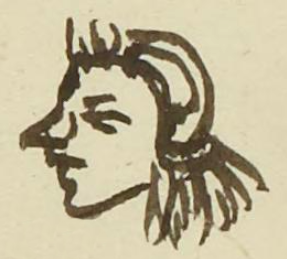Mexi (MH659r)
This black-line drawing of the simplex glyph for the personal name Mexi (or Mexih with the glottal stop), attested here as a man’s name, refers to the divine force Huitzilopochtli and the ancestral people who brought him in the migration that settled Mexico-Tenochtitlan. Chimalpahin (1997, 1:69) says a younger brother of Moctecuhzoma was named Mexi. Either way, this was a powerful name. The drawing shows the head of a man (probably a priest or an ixiptla of the deity) in profile, looking toward the viewer’s left. He has long hair that is bound at the base of the back of his head. He also has short spiky bangs.
Stephanie Wood
This name could also serve as an ethnic identity for a person from Mexico City. What is unclear in this particular example is whether it is a name honoring the deity or an ethnic label. Elsewhere in this digital collection, the ethnic glyph Mexicatl, which seems related, shows a man with long hair; perhaps this was originally an ethnic hairstyle. Also interesting is the difference between the long hair and the short hair with a bald spot on one of the other glyphs for Mexih in this collection. The bald spot is reminiscent of a friar, which makes one wonder whether, in that case, Mexih was beginning to show the fusion of the concept of a Nahua priest with that of a European priest/friar.
Stephanie Wood
po. mexih
Pedro Mexi (or Mexih)
Stephanie Wood
1560
Jeff Haskett-Wood
Mexicas, Mexica, Mexicatl, deidades, fuerzas divinas, religión indígena, nombres de hombres, pelo largo, cabello largo

Mexih, a person affiliated with Mexico City, and another name for Huitzilopochtli, taken as an ethnic name by the migrants who were carrying him and settling Mexico-Tenochtitlan, https://nahuatl.wired-humanities.org/content/mexih
ixiptla(tl), a figure conflated with a divine force, https://nahuatl.wired-humanities.org/content/ixiptlatl
Mexi, Mexih, Mexicatl, Nahua, o Mexicano
Stephanie Wood
Matrícula de Huexotzinco, folio 659r, World Digital Library, https://www.loc.gov/resource/gdcwdl.wdl_15282/?sp=398&st=image
This manuscript is hosted by the Library of Congress and the World Digital Library; used here with the Creative Commons, “Attribution-NonCommercial-ShareAlike 3.0 License” (CC-BY-NC-SAq 3.0).






